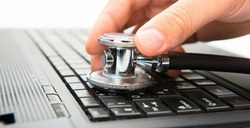 In the world of business, continuity planning is vital to the overall operational success of every type of profitable company. Technically defined as a strategic, functional organizational outline, a business continuity plan has to be in place to assist businesses when they are faced with unforeseeable risks or potential dangers. This can include anything from a natural disaster to an unpredicted, rapid decline in any specific economy. In order to develop an effective continuity plan, every possible business related hazard must be evaluated in regards to potential negative situations that can occur. Once each specific issue has been identified, it's extremely important to implement a plan that will allow your business to operate. A business continuity plan will look at the current business structure as a whole and allow for plan designing in order to prevent any unrecoverable circumstances from happening. For example; what if your company building catches on fire or a tree falls on the roof? These are both exact situations that must be taken in to account so that your business will continue to strive. Without properly planning for a wide range of potentially crippling incidents, your organization could face operational downfalls. Below is a basic overview of how to plan for potential business disasters from Iconic Mind, an IT consulting company offering business IT services for small-to-medium sized businesses. Steps to Develop a Successful Continuity Plan for your Business
In order for a company to construct a blueprint for unplanned events, there are a few essential steps that must be taken. For a business continuity plan to be successful, the most important aspect is evaluation. By evaluating a long list of potential risks, businesses will be able to implement certain strategies that will ensure long-term operational success. This stage of the planning will also allow for each conceivable danger to be evaluated in order determine the level of risk that is associated with it. Some specific risks that need to be assessed in order to maintain the overall business operation include communications, IT solutions, employee relations, production, distribution, vendor relations, customer alliance and legal regulations. The second most important step in creating an effective continuity plan for a small business is the actual implementation phase that takes into account all of the evaluating that has been done. This stage will put all of the previous evaluations into action. When putting this plan into place, it's important to know what parts of the business are the most instrumental to the overall operational success. An effective way to research the most important areas of a business are to interview the most knowledgeable departmental employees. By doing this, you will be able to gain some keen insight from experienced, specialized employees. In addition, during the implementation of a successful business continuity plan, an inventory of all the company assets must be done. These specific assets could include anything from company supplies to human resources based data. Once the inventory process has been completed, you will have to research and determine what the most cost-effective strategy for your business is. While the process of developing and establishing an powerful business continuity plan can be somewhat lengthy and difficult, it is absolutely necessary in order to guarantee future existence for your company.
 The bring-your-own-device (BYOD) trend looks like it won't be going anywhere, as the latest reports show that 50% of employees surveyed already stated they were already utilizing their own device in the business setting and this phenomenon will continue to grow. Employee satisfaction and retention are obvious motivators. Additionally, 47% of executives surveyed believe that BYOD can boost productivity in the workplace. In fact, a recent study performed by Cisco showed that BYOD employees gained a global average of 37 minutes of productive time per week
All of this is great news for small business. By embracing the BYOD craze, small businesses can save money associated to carrier plan costs and hardware costs. However, all these great benefits can come at a great cost. Personal mobile devices rank among the greatest security threat that your business can come to face. Without having some sort of policy in place, you risk having your data and network compromised. Make a policy You can't expect your employees to know how to best use their devices without an official company policy. The policy should incorporate some of the following essential items: - Specify when and where employees can use their personal devices for work functions.
- Clear define what type of devices and models are acceptable.
- Guidance on application procurement and use.
- Clearly outline and define who will be in charge in case of questions or troubleshooting.
- All applicable expense-related information.
- Consequences for any employee found to be violating any of the rules within the BYOD policy.
- Data encryption statutes and any other user-facing security components.
One word of caution: you shouldn't make exceptions to your policy for anyone, not your IT team, not management and not for you. It's important that you and key employees set an example, otherwise employees will ignore your policy, in addition to the fact that anyone (including you) who disregards the policy can potentially expose company data to outside threats,Control data and disconnect as neededYou should have full control of how much data any one employee can access and what type of data. Never give employees the power to have more access than necessary to get the job done. It's also important that there's a method to disconnect access to company data from an employee's personal device on the chance that an employee that gets fired or leaves voluntarily. Data segregationIt's fundamental that corporate and personal data gets separated in case of litigation, compliance-related audits, and other related issues. To do this successfully, you should provision corporate storage space and educate employees on the methods for backing up their data there and for keeping their personal information out. Security basicsIt's imperative that you deploy antivirus and malware solutions across all mobile devices. There should be a process in place to maintain and upgrade the software as necessary. One of the most important things that small businesses need to worry about is their network security. While allowance for BYOD has many benefits, if not handled properly, can cause network security issues for your business. Thankfully, organizations can implement a variety of solutions to minimize outside threats.
 All levels of an organization can benefit from a business intelligence solution. It simplifies information discovery, provides easy access to data, engages customers, and drives overall revenue. Many small-to-medium sized businesses shy away from a BI solution because of its assumed complexity. However a tool that was once relegated only to the domain of large organizations is now becoming easier to implement, allowing SMBs to better analyze their data.Simple tools like the dashboard are specifically created for employees who may not have the same technical know-how as their IT staff. Anyone can now harness various amounts of big data to facilitate their daily tasks. Business intelligence ties strategy to metrics to develop a deeper knowledge about daily information. "With technologies such as open source, cloud computing, and newer visualization technology, BI software is becoming more friendly to small and medium sized businesses, allowing them to easily slice-and-dice the information and spot some interesting trends within minutes,” says Mark Greene, technologist at Iconic Mind, an IT consulting company that helps SMBs leverage the use of their technology. Learn how every department within your company can function on a much higher level with a BI tool in place. MarketingBusiness intelligence offers a layered approach to vendor-client relations through big data analytics and multi-channel marketing. With tools like enterprise dashboards and balanced scoreboards, the marketing department can mine customer data for a deeper context. This allows them to refine segmentation, and target specific markets across various channels. Companies that employ these tools can use BI to determine where to place their efforts, and where to space their efforts. Big data is commonly utilized for marketing mix modeling, as well. This allows them to study channels like social media platforms to determine the overall effectiveness of each, and campaign accordingly. BI is connecting marketing to the customer in a deeply involved way. Customer ServiceCustomer relationship management (CRM) tools serve as the business intelligence force behind the customer service department. They are simple tools that allow real time interactions with customers. The software is usually set up as a dashboard with a ticket based system. It allows for a two way vendor-client interaction on various platforms. CRM’s usually contain a forum, live chat and help desk. Customers can create and assign their own requests, and manage them in conjunction with the customer service representatives. CRM’s can also be linked to social media to interact with customers and receive feedback. Since the onslaught of social media channels, this tool has become essential to an informed and successful customer service department. SalesSales are perhaps one of the departments that can benefit most from BI software. Solutions like predictive analytics allow the department to forecast in the most refined sense ever. Various amounts of big data can be analyzed to help acquire, retain, and establish lifetime value with customers. What a client buys, where they buy it, and how much they typically spend, can all be computed into a prediction on their future behavior. An organization with a good BI solution in place will have massive input, with little output. Intelligence in business is designed to increase profitability while minimizing expense. Sales intelligence (SI) is a form of business intelligence that is specifically designed to provide real time analysis of sales data sets. It can also identify up-sell and cross-sell opportunities in record speed. Human ResourcesEach department has their own unique set of data to contend with. For the human resources department, that involves vast amounts of employee information. A business intelligence solution for HR has to be particularly secure. Employee profiles, wages, benefits, and other classified data must be protected. HR analytics and reporting software is specifically designed to integrate secure data warehousing. It incorporates flexible security levels for various points of end user access. By tailoring access to sensitive data, the entire department can utilize business intelligence for reporting analysis. FinanceBig data is killing the spreadsheet and finance must find another way to process and analyze the vast amounts of data. Reporting analysis and data warehousing are tools that can be used to discover trending and take swift action. Profit and loss margins are easily accessed, and can be analyzed at a department or group level. A good business intelligence solution for a finance department will be able to perform tasks like: consolidating transactions, instant reporting, and real time analysis. Traditional accounting software is not designed to deliver insight on effective business management - BI software is. Business intelligence is a growing trend that is useful to everyone. Whether it is analyzing the demographics of the workforce, or engaging on a social platform with a customer, it proves an effective tool across the board. Every department can benefit from the in depth analysis and real time interactions provided by BI. It is a smart, modern solution that has proven success.
 The most common reason that consumers replace their computers, other than for a complete malfunction, is due to the fact that their current computer is either too slow for day-to-day tasks or due to overall poor performance according to a recent Harris Interactive poll. Because most people don't know the basics when it comes to computer maintenance, they'll typically see a degradation in their systems as time progresses. For the most part, the issue isn't due to their current hardware configuration, but instead due to a failure of basic computer maintenance such as running a virus or malware scan, updating security patches or overloading the system, among other things. The great thing is, even if you don't know much about computers, you can still make use of these easy to follow steps listed below. By performing these basic PC maintenance tasks, you'll be able to keep your computer running reliably, at optimal conditions, letting it last much longer until needing to replace. Run Your Spyware and AntiVirus Programs and Keep Them UpdatedHaving a top notch spyware or antivirus program won't do you any good if you aren't updating them on a regular basis. The updates will have the latest virus and malware definitions in places. You can typically configure your applications to do automatic updates, and these should be done at least once a week.
Aside from updating your software, it's also important to have it running. Most antivirus and malware applications will boot up with Windows - you can verify by checking your Windows tray. Make sure to run a scan at least once a week as well - you can do it right after getting the latest updates. Keep Your Applications and Utilities PatchedBelieve it or not, all of the applications and utilities on your system are prone to being exploited which is why you must make sure to update them regularly, just as you would do with your antivirus program. Programs that you use regularly like Skype, Adobe Acrobat Reader, Firefox (or other internet browser) as well as your operating system require both maintenance and security updates from time to time. It can be difficult trying to keep track of all the software you have installed on your computer and which ones need an update, which is where Secunia PSI comes in. It's a little utility that's free and monitors your PC for any applications that you might be running which could be susceptible to being exploited. When if finds one, it'll direct you to the appropriate website where you can update the necessary files to patch the software. Clean Temporary FilesWindows can leave a lot of clutter and temporary files lying around your hard drive, and it's a good idea to clean these up regularly. The easiest way to take care of the clutter is by using CCleaner, a tool that is both easy to understand and effective at getting rid of some of those unnecessary files that are bogging down your system.Run a Defragmentation ToolDisks become fragmented as files and folders are created and deleted, as well as when software is installed or when new files are downloaded. What happens is as you start deleting existing files and writing new ones, the first available empty space on the hard drive gets filled randomly with your new files. As this process goes on, pieces of the file for your new application get spread out all over the place, causing the drive head to dart all over the disk. As your hard drive gets more fragmented, the file transfer process gets slower and slower. By running a defragmentation tool, you not only get rid of unnecessary files, but you clump files into closer clusters, which helps to improve hard drive speed and keeps the drive in good shape. You should run a defragmentation of your hard drive at least every three months. To use a defragment tool, you can either use the default defragmenter that comes with Windows by going to the start menu and then going to accessories, system tools, and then Windows defragragmenter or you can download a freeware tool like Auslogics Disk Defragmenter. Of course, this all assumes you have a relatively decent hardware setup that's able to handle the work you need to do. If you're looking to run the latest version of Photoshop on a 10 year old machine, it doesn't matter how well you take care of your PC - you'll never get the application to run fast. However, barring really old hardware, by taking care of your computer, you'll be able to get it to run smoothly and at peak performance.
|




 RSS Feed
RSS Feed